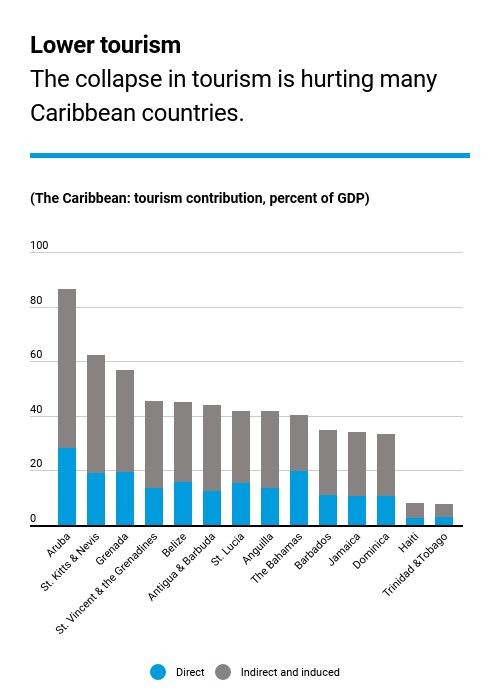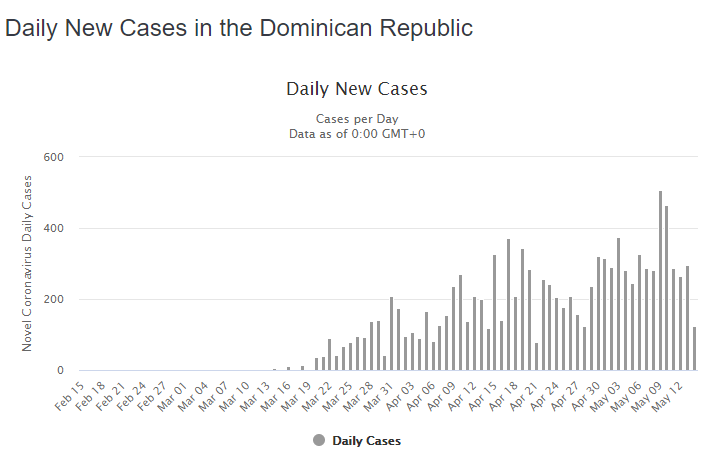People of the Caribbean are known for their resilience. After all, few other populations have faced a constant risk of life threatening hurricanes the way people of this region have. Yet, COVID-19 has brought threats to the islands unlike any before and these may be impossible to overcome in the short and medium term. Whereas Caribbean islands may have had better lack isolating themselves from the threat of the virus because of their geography, the economic impact that the pandemic is already having and will have for months (and possibly years) to come, is dramatic and carries grave consequences.
Lack of tourism is having a dramatic effect on the Caribbean economies
The reason for this is simple. The Caribbean economies are heavily dependent on tourism. In fact, according to stats from the International Monetary Fund, many of the islands in the region derive over 50% of their GDP and employment from international visitors. The islands that are at highest risk are the ones where this percentage number is highest. Below table from the IMF shows how they compare against each other:

As you can see, for islands like Aruba, St.Kitts & Nevis or Grenada, their dependence on tourism is very high. As long as the pandemic keeps this type of economic activity down by 95%, the well-being of these islands and their people are at major risk. However, even for countries like Haiti or Trinidad & Tobago where tourism makes up less than 10% of the economic activity, COVID-19 brings a negative impact in other ways. First of all, a significant drop in price of commodities that these countries export such as oil, mining and even agricultural goods is having a big impact on their bottom lines. Second, stay at home orders and temporary closures of businesses are also having an impact on the ability of Caribbean businesses to keep productions going and their staff employed.
Getting medical supplies has been difficult for the region
If all this wasn’t enough, the Caribbean islands are having a very tough time fighting the pandemic itself. In early April the Trump administration directed U.S. Customs and Border Protection to prevent export of medical equipment used to fight the pandemic overseas including the Caribbean, which has heavily relied on supplies from the US during previous crisis caused by hurricanes. As the Miami Herald reported, tens of shipments of ventilators, masks and other equipment intended to fight COVID-19 has so far been intercepted by US Customs on their way to the Caribbean and turned back to the US. When Caribbean officials tried to intervene with their US counterparts, in most cases they would end up receiving a short notice: “Due to a April 3rd, 2020 Presidential Memorandum regarding the allocation of certain scarce or threatened health and medical resources for domestic use, the items below cannot be exported until further notice.” Therefore, not only do Caribbean islands have very limited medical resources and professionals who can deal with seriously ill patients, they are also constrained in acquiring more of critical equipment they need.
Every part of the Caribbean has experienced the COVID-19 outbreak
This is a very challenging situation taking into account that every island in the region has had to deal with an outbreak of the virus. As you would expect, places with highest population have been impacted the most. As of May 15th, The Dominican Republic with a population of close to 11 million has recorded 11,320 COVID-19 cases so far, which is the highest in the Caribbean. The 1,045 cases per million people ratio isn’t very high compared to most other countries, yet it has still put a significant strain on the healthcare system in this developing country. Additionally, despite introducing social distancing measures across the country, the DR has not seen a decrease in the daily new cases of the virus. As the chart below shows, if anything, the country is still seeing the numbers going up:

Like the Dominican Republic, other countries of the Caribbean are also seeing significant number of new COVID-19 cases and have not been able to bring the pandemic under control, never mind eliminating it completely. The table below shows a breakdown of cases in the Caribbean with the most impacted regions first (sorted by the number of cases):
| Number of cases | Total deaths | Total cases per million | Deaths per million | |
| Dominican Republic | 11,320 | 422 | 1,045 | 39 |
| Puerto Rico | 2,542 | 122 | 751 | 36 |
| Cuba | 1,830 | 79 | 162 | 7 |
| Jamaica | 509 | 9 | 172 | 3 |
| Haiti | 273 | 20 | 24 | 2 |
| Martinique | 189 | 14 | 504 | 37 |
| Guadeloupe | 155 | 13 | 387 | 32 |
| Trinidad and Tobago | 116 | 8 | 83 | 6 |
| Aruba | 101 | 3 | 947 | 28 |
| The Bahamas | 96 | 11 | 244 | 28 |
| Cayman Islands | 93 | 1 | 1,417 | 15 |
| Barbados | 85 | 7 | 296 | 24 |
| US Virgin Islands | 69 | 6 | NA | NA |
| Saint Martin/Sint Marteen | 39 | 3 | 1,011 | 78 |
| Antigua and Barbuda | 25 | 3 | 256 | 31 |
| Saint Lucia | 18 | 0 | 98 | 0 |
| Curacao | 16 | 1 | 98 | 6 |
| Dominica | 16 | 0 | 222 | 0 |
| Saint Kitts and Nevis | 15 | 0 | 282 | 0 |
| Turks and Caicos | 12 | 1 | 310 | 26 |
| British Virgin Islands | 8 | 1 | 265 | 33 |
| Saint Barts | 6 | 0 | 608 | 0 |
| Anguilla | 3 | 0 | 200 | 0 |
As you can see, no region has been able to avoid the virus although some places like Anguilla, British Virgin Islands and Saint Barts appear to have had minimal impact and only a few cases. Of course, the actual number of sick people could be much higher, but like most countries around the world, the Caribbean has also been hampered by lack of testing capabilities.
Still, even when the pandemic itself is resolved, the economic impact on the region will continue for years to come. While airlines and cruises will not bring back their full fleets to activity for at least another 6 months, people’s travel habits are unlikely to get back to normal for even longer. This will put a huge strain on Caribbean businesses in the tourism and travel industries. In the coming months we will interview some of these businesses to learn about their experiences during the pandemic and how they have been dealing with challenges of the last several months. Stay tuned!

